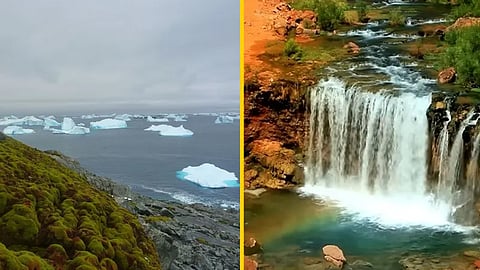

Sahara Desert Green, Antarctica Green, Why Sahara Desert Turning Green, Why Antarctica Turning Green: World scientists and users on social media have been shell-shocked ever since NASA dropped a satellite video of the Sahara Desert turning green. The Sahara Desert which is among the world's driest places is witnessing an advent of greenery in its region. Yes! you heard it right. Adding to this, Antarctica which was covered with ice everywhere is also turning green. Hence, Sahara Desert Green and Antarctica Green have been puzzling not only the common people but also the expert geological experts around the world. Below is why the Sahara Desert and Antarctica are turning green-
With an area of 9,200,000 square KM, Sahara is the largest hot desert in the world and the third-largest desert overall, smaller only than the deserts of Antarctica and the northern Arctic. NASA's latest satellite video proves that Sahara is turning into lush green rather than sandy yellow. As per reports, the reason behind this phenomenon is heavy rainfall in the area. It is due to heavy rainfall that the barren Sahara desert is witnessing vegetation sprouting in the barren area. NASA's satellite images reveal patches of plant life emerging in the desert following an extratropical cyclone that drenched parts of northwestern Africa on September 7 and 8. Regions in Morocco, Algeria, Tunisia, and Libya, which rarely receive rain, are now showing traces of green.
On the other hand, Antarctica which is known for its white landscape due to ice is also turning green. Scientists from the universities of Exeter and Hertfordshire used satellite imagery and data to analyse vegetation levels in Antarctica, which has been warming at an alarming rate, much faster than the global average. Reports suggest that the team of researchers found plant life - mostly mosses - and said the green cover has increased 10-fold over the past four decades or 40 years. In the study, scientists point out that Antarctica is turning green at a "dramatic" rate due to global warming.
The answer is no. The unusual rate of growth of flora in the Sahara may look pretty but this is a devastating sign for the things to come. Climate change is changing the tracks of storms. As per reports, in Africa, it has moved the storm system northwards. Therefore, rainfall in the region has become stronger and more frequent. Within a matter of days, North Africa received a year's worth of rainfall.
So, typically dry areas like Niger, Sudan, Libya or Egypt have received more than 400% of their typical rainfall since July 2024. Now, there is catastrophic flooding. Reports suggest that about 4 million people have been severely impacted and the Sahara Desert is six times wetter than it should be. Meanwhile, since the storms have shifted some countries that should be getting more rainfall like Nigeria and Cameron have getting fewer rains.
Shrubs and trees are growing in low-lying areas like riverbeds, explained Sylwia Trzaska, a climate variability researcher at the Columbia Climate School. Peter de Menocal, president of the Woods Hole Oceanographic Institution, noted that while it's rare, plant life does respond quickly to heavy rain events in this part of Africa. When substantial rain falls, dunes transform into lush, green landscapes for a brief time as plants take full advantage of the moisture.
Talking about Antarctica, increasing green areas could lead to more soil formation, making the region suitable for invasive species, which may harm local wildlife. The greening could also reduce Antarctica's ability to reflect sunlight as darker plants absorb more heat. Furthermore, scientists reportedly believe that this process will speed up as the climate continues to warm, leading to more dramatic changes in the region's landscape.